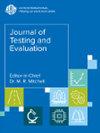不同温度下水工沥青混凝土压剪性能试验研究及机理分析
IF 0.8
4区 材料科学
Q4 MATERIALS SCIENCE, CHARACTERIZATION & TESTING
引用次数: 0
摘要
水工沥青混凝土(HAC)作为一种典型的防渗结构,在堤防大坝中得到了越来越广泛的工程应用。然而,HAC在压缩-剪切复合应力下的力学性能研究仍然有限,特别是考虑到它的温度敏感性。因此,本研究研究了不同温度和正压应力下HAC在压剪复合应力作用下的力学行为。具体而言,得到了不同温度和正压应力下HAC的破坏模式、应力-应变曲线、峰值剪应力和应变。实验结果表明,正压应力和温度的共同作用会引起峰值剪应力和相关剪切应变的变化。增加的正压应力导致垂直限制和水平裂缝的出现,变形在高温下放大。在这些条件下,HAC的所有破坏模式都不存在剥落颗粒和碎屑。观察到,随着正压应力的增加,峰值剪应力逐渐增大,而温度的升高导致峰值剪应力明显减小。HAC的抗剪强度包括沥青基体的内聚强度和集料与沥青的界面粘附强度。最后,针对不同温度下的HAC,建立了3种具有较好预测精度的修正压剪破坏准则。本研究为今后HAC的研究和工程应用提供了理论参考。本文章由计算机程序翻译,如有差异,请以英文原文为准。
Experimental Study and Mechanism Analysis on Compression–Shear Behavior of Hydraulic Asphalt Concrete at Different Temperatures
Hydraulic asphalt concrete (HAC), typically employed as an impermeable structure in embankment dams, is increasingly recognized for its widespread engineering applications. However, investigations of the mechanical performance of HAC under combined compressive–shear stress remain limited, particularly given its temperature sensitivity. Therefore, this study investigates the mechanical behaviors of HAC under combined compressive–shear stress at diverse temperatures and normal compressive stresses. Specifically, the failure modes, stress–strain curves, peak shear stress, and strain of HAC under various temperatures and normal compressive stresses are obtained for analysis. Experimental results demonstrate that the combination of normal compressive stress and temperature induces changes in peak shear stress and correlated shear strain. Increased normal compressive stress results in vertical restriction and the emergence of horizontal cracks, with deformation amplifying at elevated temperatures. All failure modes of HAC under these conditions are absent of spalled fines and debris. It is observed that as the normal compressive stress increases, the peak shear stress progressively increases, whereas an increase in temperature yields a clear decrease in peak shear stress. The shear strength of HAC comprises the cohesion strength of the asphalt matrix and the interfacial adhesion strength between aggregates and asphalt. Finally, three modified compressive–shear failure criteria that exhibit good prediction accuracy are established for HAC at diverse temperatures. This research offers a theoretical reference for the future investigation and engineering application of HAC.
求助全文
通过发布文献求助,成功后即可免费获取论文全文。
去求助
来源期刊

Journal of Testing and Evaluation
工程技术-材料科学:表征与测试
CiteScore
2.30
自引率
8.30%
发文量
221
审稿时长
6.7 months
期刊介绍:
This journal is published in six issues per year. Some issues, in whole or in part, may be Special Issues focused on a topic of interest to our readers.
This flagship ASTM journal is a multi-disciplinary forum for the applied sciences and engineering. Published bimonthly, the Journal of Testing and Evaluation presents new technical information, derived from field and laboratory testing, on the performance, quantitative characterization, and evaluation of materials. Papers present new methods and data along with critical evaluations; report users'' experience with test methods and results of interlaboratory testing and analysis; and stimulate new ideas in the fields of testing and evaluation.
Major topic areas are fatigue and fracture, mechanical testing, and fire testing. Also publishes review articles, technical notes, research briefs and commentary.
 求助内容:
求助内容: 应助结果提醒方式:
应助结果提醒方式:


